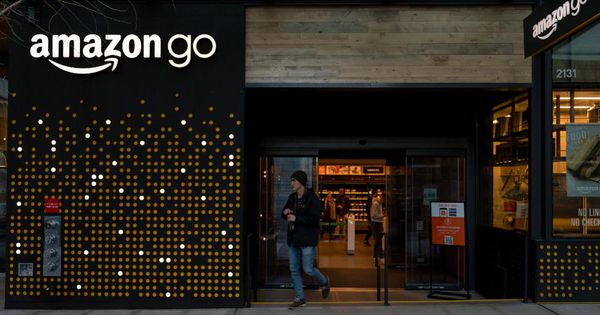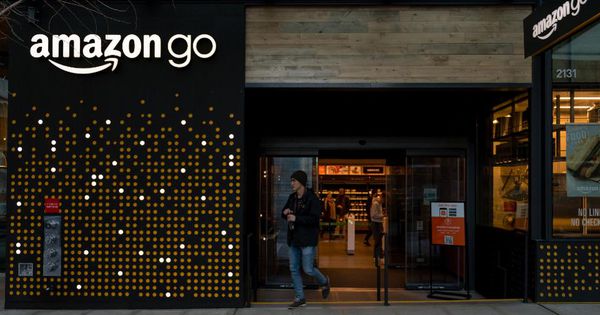
Seattle, USA – Mar 1, 2019: The original Amazon Go Store in in downtown late in the day.Getty
You would have to be living under a rock to have avoided the stories proclaiming the retail apocalypse that has hit the UK and US over the last couple of years. So, far this year over 4,300 stores have been earmarked for closure in the US alone.
People proclaim that the offline retail is dying and there is nothing we can do to stop this decline, but with only 10% of sales being generated online in the US in 2018, bricks and mortar stores still play a vital role.
But that’s not to say they don’t have to adapt and change their propositions to suit the modern day consumer and their ever-changing needs, especially in urban locations.
Powering this change will not be via small tweaks, it will be through adoption of new technologies to enable a more seamless experience for consumers and one that fits their evolving expectations and wants – at least for companies who do not operate in the stack it high, sell it cheap end of the market.
Retailers are now swamped with new technologies to help with these changes and reinvigorate their store estates but what actually makes a difference? With their reducing resources what can actually impact the bottom line?
Firstly, there is merging online and offline which drives online customers to become in-store traffic. This can be done through click and collect opportunities but is also being frequently driven by in-store experiences, think Marks and Spencer’s Fit & Style Studio; an in-store personal styling service powered by Appointedd. This solution means online shoppers can easily book appointments instore from the retailers website.
Leah Hutcheon, Founder & CEO of Appointedd said: “Online booking has allowed Marks & Spencer to use their online presence with more than 35 million monthly website visitors to facilitate and drive demand for their Fit & Style experience. We’ve seen that when retailers introduce services to merge online and offline, their average sale price increases thanks to cross-selling opportunities as well as encouraging long term customer loyalty.”
A lot of retail companies now talk about how they’re striving to create experiences in their bricks and mortar stores but how technology feeds into this is still up for debate.
The best examples seem though to focus on community and not just technology. The cycling brand Rapha has seen great success with their Clubhouse approach where they place coffee shops in store and people can become members for discounts on products, access to cycling events and free coffees. This approach ensures a high level of footfall in the stores and allows the company to build a strong community with its consumers, all with little or no technology!
Where companies have adopted technology to power ‘experiences’ it’s on a relatively small scale due to the potential cost to roll out many of these approaches, especially where things like augmented and virtual reality are put in place.
One area of focus though is VR, Topshop in 2017 introduced a VR waterslide to their flagship Oxford Street Store to help engage consumers, whilst it clearly drove footfall how it built a long-lasting community is up for debate.
Both Neiman Marcus and LVMH have both utilized AR within their changing rooms through smart mirrors that enable consumers to take pictures of an outfit, compare two different looks side by side and show front, side and back together – or even change the colors of the outfit without having to change.
One of the leaders in this space is Memo Mi who claim to have developed the worlds most advanced smart mirror that combines AR with AI and doesn’t just work with fashion companies but allows consumers to try on makeup without actually trying it on…
Whilst not nearly at mass adoption yet, as a concept it’s clear to see why this would be appealing to retailers and consumers alike. The likes of Sephora and Warby Parker have adopt this technology into their mobile apps to the detriment of offline shopping though and this must remain to be a worry for retailers with large store estates, why go into a store to try on glasses when you can use app and do it from the comfort of your own front room?
Payment technologies are now also helping to drive consumers into stores, both Laybuy and Klarna have launched products retailers to let consumers buy a product on the spot and then pay for it over the coming weeks and months in small payments.
Clearly attempting to replace the in-store credit card for millennial shoppers, who have very low adoption rates for credit cards due to their approach to finance.
Whilst both concepts have clear value online, the offline experience angle is now helping to drive consumers into store as well.
“By integrating Laybuy, retailers can offer customers increased choice and flexibility to their customers at the point of sale. Consumers can easily sign up for free at the checkout and spread the cost of desirable purchases over six weekly interest free payments. Retailers are paid the full purchase price up front, minus a small commission and Laybuy absorbs all the financial risk. On average, retailers partnering with Laybuy have seen an increase in order value of 60% to 100%, an increase in in-store and online conversion rates of between 15% and 50% and an increase in new customer acquisitions of 30% to 50%.” Gary Rohloff, Managing Director of Laybuy claims.
The next focus of driving people into store using payments is the Amazon Go store and their focus on making the shopping experience frictionless with no checkout needed. Wither this drives footfall or just makes for a better experience is to be debated as the rollout continues.
It’s clear that technology offers retailers the opportunity to tackle some of the problems their stores face due to the changing face of retail but the real question is how quickly will they adopt them and ensure they generate the correct mix of offline and online sales?
Many retail companies are like oil tankers and take a long time to adapt to the changes that technology is driving, many are pinned down by debt and banking covenants that reduce their ability to invest and many have been hindered by a short term view of the sector. The real challenge for many now is they need to innovate and they need to innovate fast!

